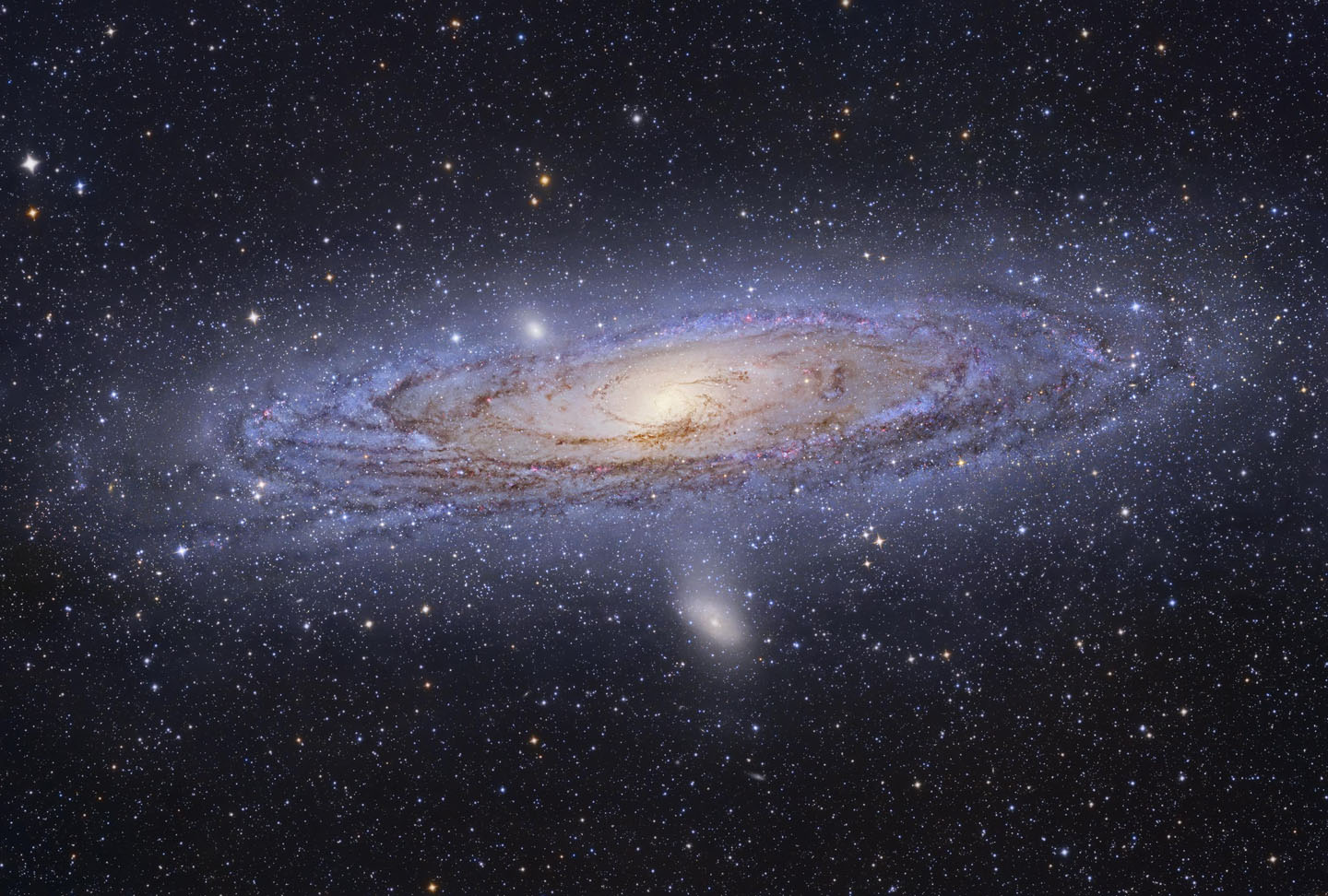







| BOOKS | F. A. Q. | ARTICLES | TALKS | ABOUT KEN | DONATE | BEYOND OUR KEN |
|---|
By Ken Croswell
Published in Highlights for Children (December 2007).

Image by Tony and Daphne Hallas. Used by permission.
The Andromeda Galaxy is the closest giant galaxy to our own. By observing Andromeda, astronomers have learned a lot about our Galaxy, the Milky Way.
What about the Milky Way Galaxy? People wondered whether it was a spiral, too. But they couldn't tell. We live in the Milky Way, so we can't see it from the outside.
Astronomers counted the Milky Way's stars in different directions. They hoped to see a spiral pattern. But they didn't succeed.
Fortunately, the Andromeda Galaxy helped. Walter Baade, an astronomer in America, took a photograph which showed red clouds of gas that lined up with Andromeda's spiral arms.
Another astronomer in America, William Morgan, saw that photograph and had an idea. Since red clouds of gas trace Andromeda's spiral arms, he thought they might also trace the Milky Way's spiral arms. So in 1951, Morgan mapped the locations of all the red clouds of gas he and his colleagues could find. He discovered that the gas clouds lined up along spiral arms, indicating that we live in a spiral galaxy.

Why do red clouds of gas trace the spiral arms? It's because spiral arms give birth to stars. The brightest newborn stars are hot and blue, so spiral arms are blue. The blue stars give off ultraviolet radiation--light waves that are shorter than your eye can see. This ultraviolet light carries lots of energy and makes gas glow red. So, strangely enough, gas can turn red when it's near blue stars.
The stars of Andromeda even reveal how far away the galaxy is. It works like this. Astronomers observe a type of star in Andromeda. Then they compare the star with the same type of star in the Milky Way. The fainter the star in Andromeda looks, the farther away Andromeda must be.
It's like seeing a distant streetlight. By comparing its faintness with the streetlight in front of your home, you can estimate how far the distant streetlight is.
Andromeda is 2.5 million (2,500,000) light-years away. One light-year is a long way: it's the distance light travels in a year, about 5.88 trillion (5,880,000,000,000) miles. So the Andromeda Galaxy is about 15 quintillion (15,000,000,000,000,000,000) miles from Earth.
Believe it or not, that's not very far--at least, as galaxies go. Andromeda is so close that it is part of the Local Group of galaxies.
The Local Group has dozens of galaxies. Andromeda is the brightest one in the Local Group. Our Galaxy, the Milky Way, ranks number two.
The photograph here shows two of Andromeda's satellite galaxies. The round one that appears above Andromeda's disk is called M32. The oval one below, which looks larger than M32, is called NGC 205.
Astronomers discovered Andromeda's black hole after they saw that the stars and gas near the galaxy's center move fast. Why so fast?
The Earth moves fast around the Sun. But if the Sun had much more mass than it does, the Earth would move much faster. So the very high speed of the stars and gas near Andromeda's center means there must be so much mass that it's a black hole! Astronomers calculate that Andromeda's central black hole has 140 million times more mass than the Sun.
The black hole at the center of the Milky Way is smaller--only 4 million times the mass of the Sun.
Just as the Earth goes around the Sun, the Sun goes around the Milky Way's big black hole. But don't worry: the black hole is 27,000 light-years away. Plus, the Sun moves half a million miles per hour--so fast that it won't fall into the black hole. All other stars in the Milky Way also move around the black hole at the Galaxy's center.
Likewise, all stars in the Andromeda Galaxy move around its central black hole. Perhaps some of those stars have planets with intelligent beings who have learned a lot about their galaxy--by observing ours.
Ken Croswell has written two astronomy books for children: See the Stars: Your First Guide to the Night Sky and Ten Worlds: Everything That Orbits the Sun.
"Finally! An astronomy guide that the reader can actually follow without being a rocket scientist!" See all reviews of See the Stars here.
"On the basis of its striking design and photographs, this handsome, large-format volume is well worthy of praise. And astronomer Croswell's concise yet conversational, information-packed text wins it sky-high accolades in the narrative sphere as well....This eye-opening book will feed kids' curiosity about the worlds beyond Earth. " --Publishers Weekly, starred review. See all reviews of Ten Worlds here.
| BOOKS | F. A. Q. | ARTICLES | TALKS | ABOUT KEN | DONATE | BEYOND OUR KEN |
|---|